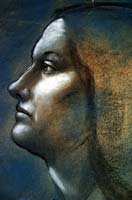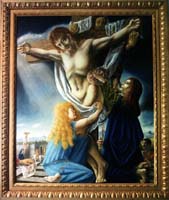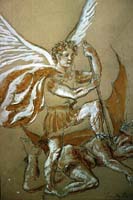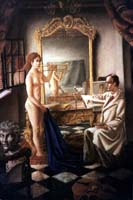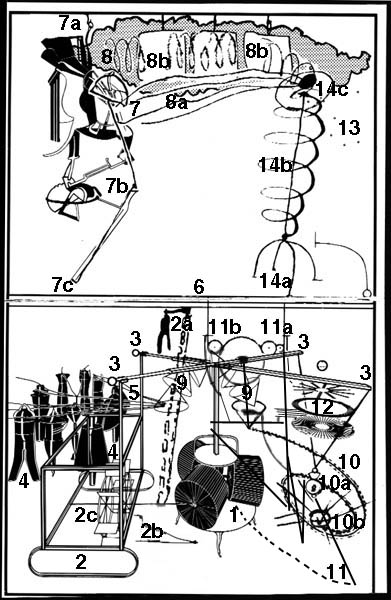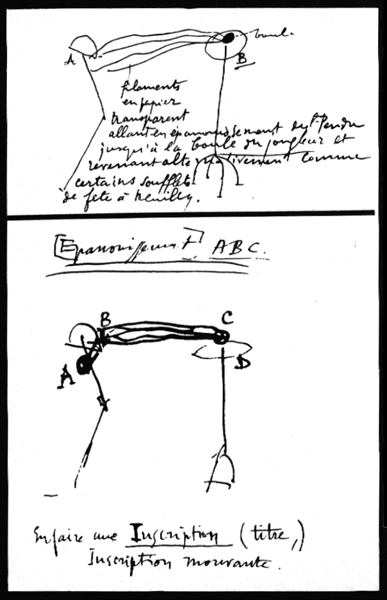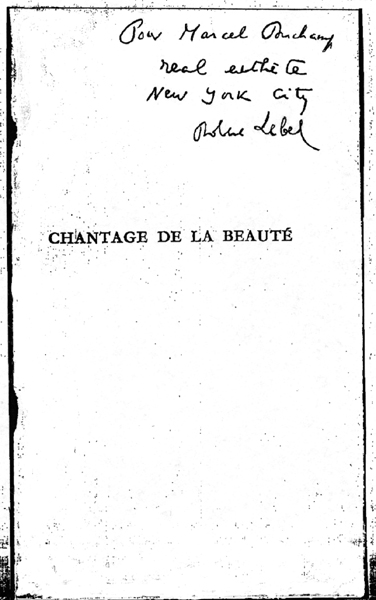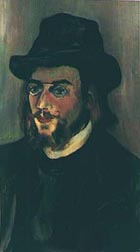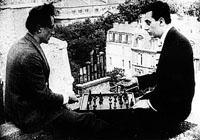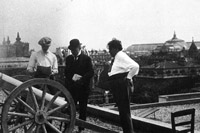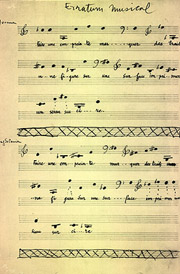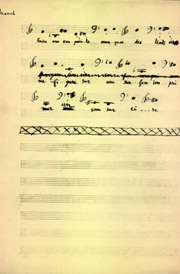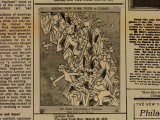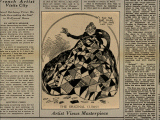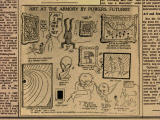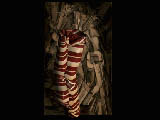click to enlarge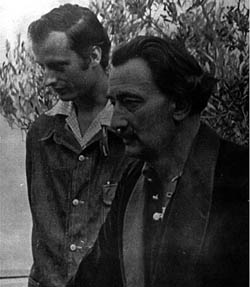
Salvador Dalí with Timothy
Phillips (left),
early 1960’s
We first learned of Timothy Phillips (b. 1929) when he wrote a letter to the editor of Canada’s National Post in response to Sarah Boxer’s article “A Self-Made Man. The Art World is Upset by Evidence that Marcel Duchamp Manufactured the Readymades he Claimed to have Found” (15 March 1999, reprinted in the Post with permission of The New York Times). The letter was forwarded to us by one of the paper’s editors. From this initial writing, a correspondence with Phillips began and it soon became apparent that he was highly interested in one of Duchamp’s fascinations: mathematics. We also became aware that he had worked as an assistant for Salvador Dalí, executing “minor details of lesser pictures.” The assistantship came about in 1949 when Phillips’ mother had her portrait painted by Dalí (Illustration 1) and Phillips went along, bringing his copy of 50 Secrets of Magic Craftsmanship for an autograph.
Perhaps intrigued by the young man’s looks and interest in mathematics, Dalí invited Phillips to his house in Port Lligat, Cadaqués, and Phillips started to spend his summers working with Dalí (who wrote later that an angel had sent Phillips across his path). In the art world of Cadaqués at that time, the young Canadian met, among others, Man Ray and Marcel Duchamp.
An active painter, Phillips maintains the Toronto-based Tappa Gallery as well as the Timothy Phillips Art Foundation. Now deeply religious, he attends services twice a week. In the correspondence that ensued after his letter to the editor, he happily shared memories of his very different lifestyle of the 1950s and 60s:
Emboldened by the example of the renowned master [Dalí], I proceeded to act in ever stranger ways. In the beginning Dalí said (in “Dalínese”): “You is not enough crazy.” When I parted company from him, he declared: “You is too much crazy!” In the interval, my apparent insanity had progressed more than his command of English. Eventually, my wealthy step-father purchased for me and my newly married – and disastrously so – wife, a mountaintop former monastery. There I took mescalin and vast quantities of alcohol (not to mention sex!), confirming to the letter Dalí’s shrewd estimate of my then mental state.
We had to meet him!
click to enlarge
Timothy Phillips, Toronto, June 1999
Thomas Girst: You seem to have had a pretty wild time while living in Cadaqués during the 1950s and 60s.
Timothy Phillips: That’s unfortunately true.
T.G. But you lived in a monastery.
T.P. First of all, I started in a fisherman’s hut which I rented and then I fell in love with a local girl. She was the daughter of an English expatriate. Staying in the monastery meant very primitive living but we stayed there for a couple of summers. Then she ran off with Jonathan Guinness who secretly turned out to have a second wife that he kept in the countryside. Well, she went where the money was and I fell in one of my down periods. That’s when I became religious. I was working for Dalí before I was married, doing mathematical calculations. I also did very minor parts of lesser pictures and he complimented my sense of tone. It is very difficult to explain to anybody who doesn’t paint what tone is. Generally, tone is what you see in a painting when you take a black and white photograph. If it’s all pale and you can’t distinguish things, if it all depends on color it is not in tone. If it is in tone, it’ll be 50% mid-tone, 25% light tone and 25% dark. And it will have a pattern of masses of tone. Apparently, tone is becoming lost. It used to be taught in schools. So Dalí said to me that I had the total sense of a Velazquez, a big exaggeration, but I’ve tried to live up to it and in a lot of pictures I haven’t./p>
T.G. Did you know Puignau, the contractor and mayor? He was important to Duchamp.
T.P. Puignau! Yes, I certainly know him. He is a great guy!
T.G.He arranged the wooden door for Duchamp’s Given to be shipped to New York. He also got the bricks for Duchamp’s last major work and helped him find a summer home, later installing a big chimney designed by Duchamp.
click to enlarge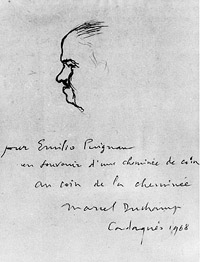
Illustration 2.© 1999 Succession
Marcel Duchamp, ARS, NY/ADAGP,
Paris Marcel Duchamp, The
Mayor of Cadaqués, 1968
T.G. Duchamp even did a portrait of him in the 60s.
A little drawing (figure 2)
.
T.P. Oh, I have to see it.
T.G. Was he friends with Dalí as well?
T.P. Oh yeah, was he ever! He was a very intelligent man. No one could be friends with Dalí without having either talent or intelligence or both.
T.G. It is said that when Dalí was with Duchamp, Dalí wasn’t the exhibitionist he used to be.
T.P.Dalí was never an exhibitionist, that was for the public. Dalí was the humblest man I’ve ever known in my life. Only interested in what he could learn, what he could absorb. A remarkable man! Duchamp was a very humble man too and so sharp and intelligent. He was a chess player, he didn’t advertise his moves. I don’t think that Dalí appreciated Duchamp until he began to deeply study mathematics and metaphysics. First of all, Dalí had this concept of Freudian analysis but then he outgrew it and became aware of not only geometrical format in painting, but the dynamic of mathematics and geometry which underpinned everything. So a little talk with Duchamp would show Dalí just where the real truth of things laid and he could then abandon these Freudian concepts and go to something far deeper, which he did. His paintings became progressively more mathematical and dynamic.
T.G. He also showed a big interest in DNA.
T.P. Yes, he was a “scientist manqué” fascinated with contemporary science and all its branches, particularly biology and physics.
T.G. As a young man, Duchamp read up on mathematical treatises, especially at the time he was working at the library Saint-Genevieve in Paris.
T.P. He did, he saturated himself in that, and I also noticed that he knew Apollinaire who was unbelievably intelligent.
T.G. He even tried to outdo de Sade by writing a more pornographic book than the old prisoner could have had imagined.
T.P.I do not know one major creative mind that did not have a pornographic streak, not one!
T.G. Can you elaborate upon when you first met Duchamp? He and Man Ray had come up to your monastery?
T.P.My wife invited them. She had a remarkable ability to meet people and socialize and she was incredibly pretty. So it was no difficulty for her to have this famous pair invited. I knew that Duchamp had a fantastic grasp of perspective and a razor sharp intellect, but I thought he was the supreme joker of modern art.
T.G. When did that change for you?
click to enlarge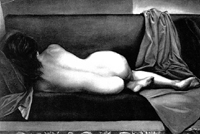
Illustration 3 Timothy Phillips,
Nude after Velazquez (Untitled),
late 1950’s
T.P. Well, I spoke to him while I was working on a study of a nude and he complimented me on the foreshortening (Illustration 3).He said how difficult foreshortenings were and I knew this was a very serious person. Just his general conversation showed a very high intelligence and I became aware that he was no joker. He said to me: “My idea is to destroy easel painting” and I thought “But this is what I am doing, why do you want to destroy it?” I believe what he wanted was to destroy the banality and the mechanicalness of what passes for painting and to introduce the beauty of “grey matter,” add a bit of intelligence into painting.
T.G. I thought the term “grey matter” did not come up with Duchamp until later in his life. Did he mention “grey matter” to you in Cadaqués?
T.P. No, he never did because he wouldn’t go into it very much. I didn’t even know he was a master chess player at that time. I did not know nearly enough about him or Man Ray. I just knew that these were famous men. I approved of Duchamp making fun of the whole modern movement because I did not like it.
click to enlarge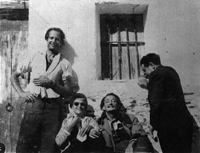
Salvador Dalí (center)
with Gala and Timothy
Phillips (left), early 1960’s
T.G. Do you have any memory of how Man Ray and Duchamp were together?
T.P. Well yeah, they were terrific. Man Ray, I think it was a joke, said to me, “I intend to paint a picture of such a nature that everyone of the spectators will drop dead,” and I said to him: “Mr. Ray, have you paid up your insurance premiums?”
T.G. You must have also met Teeny, Duchamp’s wife?
T.P. Yes, she was lovely!
T.G. Teeny and Gala [Dalí’s wife] didn’t get along…
click to enlarge
Timothy Phillips,
Toronto, June 1999
T.P. No, I am afraid not, they wouldn’t. Gala had a commercial streak. I am sure that came as a result of her childhood in Russia and her life as an ex-patriot in Paris. She became, well, not only an entrepreneur but a total opportunist. Regretfully, it spoiled the character of an otherwise wonderfully civilized woman, that’s too bad. And also of course, she was a nymphomaniac and Dalí alone couldn’t satisfy her sexually, so that boatmen or young actors or anything else would do. Eventually, Dalí got fed up and he slugged her in the Hotel Meurice. They broke up and that was the end for Dalí because she did all the business.
T.G. How did they spend their summers together?
T.P. Well, he would paint from early morning until nightfall, then after supper he’d turn on the lights and painted by artificial light. Occasionally, he’d go out on a little excursion in a yellow fishing boat with Gala and I would often come along. We’d go to those islands off Cap Creus.
T.G. Where you can see those rock formations sometimes found in Dalí’s paintings?
T.P. Yes, wonderful rock formations!
T.G. And Gala would read to him while he was painting?
T.P. Yes, she would read to him the most pornographic works that she could find: Marquis de Sade and also Rabelais.
T.G. Do you know that someone once did the L.H.O.O.Q. with Gala for a surrealist
exhibition in the 60s — the “L.H.O.O.Q., Comme D’Habitude” (Illustration 4)?
click to enlarge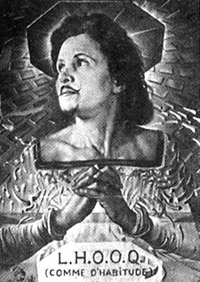
Illustration 4.L.H.O.O.Q.,
Comme d’Habitude, 1961
T.P.This is a supreme piece of irony to put the moustache on Gala. Incidentally, there was a lot of tension between Gala and Dalí. He knew that she was a nympho and that she betrayed him sexually every time she could. Dalí and Gala were a very unhappy union at the time, projecting to the public something they weren’t. But she had an amazing eye!
T.G. For his art or for young men?
T.P.Both! (laughs) Regarding Duchamp and Dalí, she didn’t like Dalí giving too much credit to anyone. Her idea was that Dalí should be some kind of a demigod, a Renaissance man who simply absorbed everything osmotically and gave it back in his own way. The fact that he would then commune with Duchamp I think disturbed her a little bit. The idea that anyone could influence Dalí was alien to her.
T.G. So when you met him was he still practicing his paranoic-critical method?
T.P. Paranoic-critical method was with him from the time he discovered it until his death. It was his basic method of creation. And it was really his way to liberate the right hemisphere of the brain because what hinders the sane person is the critique of the left hemisphere. It is critical and linear, but if you can liberate the right side of the brain you can have these wonderful insights, which are free of limiting logic. They have their own logics. There are so many different logics — irrational or non-rational and hyper-rational logics. They’re all in mathematics, so that is Dalí’s method of contacting the super-rational.
T.G. And delving into the subconscious at the same time.
T.P. But I think Duchamp showed him there was a mathematical basis for all this. It clearly fascinated Dalí to see that Duchamp could handle these things. He understood the whole field of advanced mathematics.
click to enlarge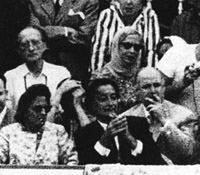
Salvador Dalí (lower center) and
Marcel Duchamp (upper left)
attending a bullfight held in
Dalí’s honor, August 1961
T.G. Hence their mutual respect.
T.P. Yes, mutual respect. A lot of mutual admiration between two geniuses. They were two minds on a single wavelength.
T.G. And in one of Dalí’s paintings, Dalí hands the crown to Duchamp, turning him into a king.
Yes, it is Salvador Dalí in the Act of Painting Gala in the Apotheosis of the Dollar, in which One may also Perceive to the Left Marcel Duchamp Disguised as Louis XIV, behind a Curtain in the Style of Vermeer, which is but the Invisible Monument Face of the Hermes of Praxiteles(figure 5) which he did three years after I broke off contact in 1962. There are so many references in the title alone. To begin with, you have the helix and its reflection.
T.G. In the background you also find allusions to Duchamp’s Nude Descending a Staircase
of 1912.
Figure 5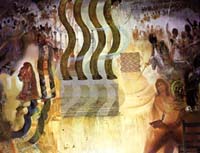
Salvador Dalí, Salvador Dalí
in the Act of Painting Gala
in the Apotheosis of the
Dollar, in which One may also
Perceive to the Left Marcel Duchamp
Disguised as Louis XIV, behind a
Curtain in the Style of Vermeer,
which is but the Invisible Monument
Face of the Hermes of Praxiteles, 1965.
Timothy Phillips and Thomas Girst
outside the Tappa Gallery
Toronto, 1999
T.P. An incredibly complex painting with the Velazquez door and the Vermeer curtain. I believe that Dalí acknowledged Duchamp as the major mind force in modern art. For me, everything else is an effervescence of superior talent, but without real significance. Besides Klee, Dalí and Duchamp, I can’t really think of many of the others as anything except being exceptional talents. Klee was a man who I think understood the insane, children and the symbolism of these minds which might in certain ways be far superior to normal minds. There might in fact be no such thing as insanity, because you can’t define sanity; and Klee’s exploration of the insane I think went deeper than Dalí’s. At the time, I thought the value of Dalí was in his superb technique. Now I think that his technique was cumbersome although he achieved miracles.
T.G. But Dalí as a person must have been much more insane than Klee!
T.P. Klee was Swiss! What do you expect of a Swiss?
T.G. Not too much of what Dalí was, with his staring eyes…
T.P. That was something he just put on. Dalí wasn’t insane at all, one of the sanest men I’ve ever met in my life. My god was he sane (laughs)!
The interview was conducted at Timothy Phillips’ Tappa Gallery in downtown Toronto,June 20, 1999. It is preserved in full on a digital videotape (filmed by Friederike N. Gauss), © ASRL, 1999.
click images to enlarge
click images to enlarge
Timothy Phillips – Picture Gallery



